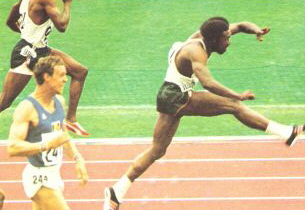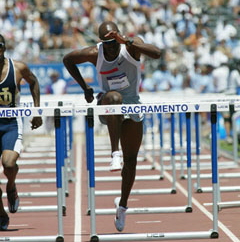



Tucking the Heel
A problem for faster hurdlers who have crowding issues between hurdles is that of getting the lead leg up and over quickly enough to avoid hitting the crossbar. The faster you are between, the quicker you have to be on top and in the descent off the hurdle. These speed hurdlers generally hit a lot of hurdles on the way up.
In past articles I’ve talked about the importance of leading with the knee of the lead leg, and yes, leading with the knee definitely does give you more room to negotiate the barrier without running into it. Another aspect of the take-off phase of hurdle clearance that serves the same purpose, and that helps to ensure that you will, indeed, lead with the knee, is tucking the heel under the butt.
Assuming that you’re running with the ankle dorsi-flexed, and the toe is not pointing down, tucking the heel under the butt provides the following advantages:
· It prevents the lead leg from swinging upward.
· It prevents the foot from getting ahead of the knee too soon.
· It decreases the space (when you are on top of the hurdle) between
your hamstring and the top of the crossbar. Because the leg is not swinging
upward, but is instead rotating over the hurdle, the hamstring will skim the
top of the hurdle, and you will feel more like you are looking down on the hurdle
instead of “jumping” over it.
· It gives you more room to clear the hurdle.
While swinging from the hip is the worst technical mistake with the lead leg, there are plenty of hurdlers out there who do, in fact, lead with the knee, but still swing the leg upward and, in effect, jump over the hurdle, because the foot still gets ahead of the knee too early. One of my favorite hurdlers ever, 1972 Olympic champion Rodney Milburn, had this problem. Back in those days, the thinking was that you wanted to drive your foot at the crossbar to ensure low hurdle clearance. The flaw in that mode of thinking, though, is that you can have very low hurdle clearance with the foot – you can even hit the hurdle with the foot – and still be high over the hurdle when the hamstring is on top of the crossbar. Tucking the heel under the butt during take-off – while the trail leg is still on the ground – is the key to fixing this problem.
Who are the best hurdlers to watch when looking at this aspect of technique? I would say that Allen Johnson is probably the best ever at tucking the heel under the butt. Because he tucks it so tightly, his lead knee is already as high as the crossbar before he even leaves the ground. Dominique Arnold is also very good at it, too.
Almost every photo of hurdlers that you'll ever see features the hurdler as he or she is in the air, on top of the hurdle. Finding a photo of a hurdler who is still in take-off mode is as about as easy as AP Calculus (not that I would know), but I did manage to scrounge up a couple good ones below:


The photo on the left is of Rodney Milburn on his way to victory
in the 1972 Olympics. The one on the right is of Allen Johnson in a semi-final
heat of the 2004 Olympic Trials. You can see that Milburn's lead foot has gotten
ahead of the knee too soon, which will cause him to elevate his hips and to
twist his hips and shoulders in order to avoid hitting the hurdle. Johnson,
meanwhile, is tucking the heel nicely, and you can see that his knee is already
high enough to clear the hurdle. So now all he has to do is rotate the foot
over the bar and, quite literally, step over the hurdle.
© 2007 Steve McGill